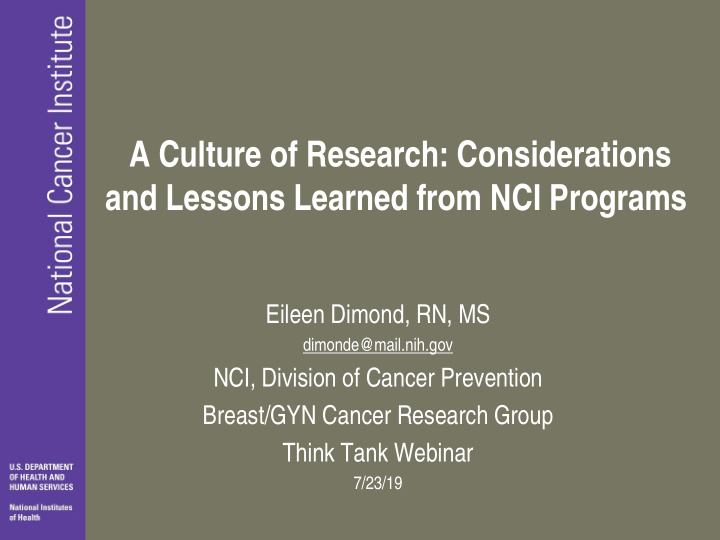



A Culture of Research: Considerations and Lessons Learned from NCI Programs Eileen Dimond, RN, MS dimonde@mail.nih.gov NCI, Division of Cancer Prevention Breast/GYN Cancer Research Group Think Tank Webinar 7/23/19
Briefly review clinical trial programs that lie Review Objective: beyond the Consortia within the NCI Explore lessons learned and Assess Assess site infrastructure/attributes for research factors that influence research Discuss strategies to build and support Examine research infrastructure culture from NCI program experience Discuss
DCP has played a significant role in establishing NCI clinical trials networks engaging varied types of sites…community, minority-based, and cancer centers in many national studies, including large prevention trials like STAR for breast and SELECT for prostate Background Experience has shown us that everyone on the team has an important role in creating and supporting the culture of research in your site’s community of practice. Accrual has to be discussed and given time and attention. The PI is key but so is the newer coordinator! How does the team, engage and create a culture of research….can you draw in and work effectively together?
NCI Clinical Trials Programs
NCI National Clinical Trials Network (NCTN)
Community and Minority-Based Clinical Oncology Programs Established in 1983 and 1990 respectively • NCI’s initial program supporting increased clinical trial infrastructure and access to cancer clinical trials in community cancer centers.
The NCI Community Cancer Centers Program (NCCCP)
New NCI Program Brings Clinical Research to the Community Setting NCORP will bring together, and build on the success of, two existing NCI programs: the Community Clinical Oncology Program (CCOP)/ Minority-Based Community Clinical Oncology Program (MBCCOP) and the National Cancer Institute’s Community Cancer Centers Program (NCCCP).
Compliance with International Conference on Harmonisation (ICH) Good Clinical Practice Guidelines (GCP) • Defines design, conduct, recording, & reporting of human subjects clinical trials. Trial Site Site specific Standard Operating Minimum Procedures (SOPs) Standards for Clinical Good Clinical Practice training by all investigators and study staff involved in Research the design and conduct of clinical trials. FDA/GCP regulatory cmpliance
Background R. Zon, et al., JCO, 2008; JOP , 2011; A. Baer et al., JOP, 2010
Diversification of CT High accrual activity Mix/Portfolio Participation in the CT Internal QA Process (trial input) “Attributes of Multidisciplinary CT Awareness Programs Exemplary CT Involvement (internal & external) Sites” Formal maintenance of high educational standards •Board Certification, SOCRA, continuing ed in research R. Zon, et al., JCO, 2008; JOP , 2011; A. Baer et al., JOP, 2010
The National Cancer Institute–American Society of Clinical Oncology Cancer Trial Accrual Symposium: Summary and Recommendations Andrea M. Denicoff, MS, RN, Worta McCaskill-Stevens, MD, MS, Stephen S. Grubbs, MD, et al J Oncol Pract. 2013 Nov 9(6): 267-76
Created for community cancer research programs striving to exceed the minimum standards of Good Clinical Practice NCI Clinical Trials Assessment of Infrastructure Matrix (CT AIM) Tool
How can this idea of infrastructure assessment be used? Program self- Benchmarking assessment, program development, and performance and improvement infrastructure Planning and Program or communicating with progress reporting senior leaders for funders or about program sponsors needs
Quality assurance CT portfolio diversity and management Physician engagement in CTs Participation in the CT process The CT Multidisciplinary team involvement AIM Tool Education standards Accrual activity (includes underserved accrual) Attributes CT education and community outreach CT workload assessment Clinical research team/Navigator engagement Biospecimen research infrastructure
Attribute Example: CT Portfolio Diversity
Significant Change in Level III Scoring Over Time for All Attributes Combined (p < 0.0001) Outreach/Underserved Accrual A QA t CT Portfolio* t Physician CT Engagement Year 3 r i Participation in CT Process Year 2 b MDC Involvement Year 1 u Education Standards t Accrual e CT Communication* 0 5 10 15 20 Number of Sites *Significant p - value for change over time (CT Communication, p 0.0281; CT Portfolio, p 0.0228)
Evolution of the CT AIM Tool • Expanded Stakeholder input – Community sites – ASCO Community Research Forum – NCI Advisors cross Division input (DCP, DCTD, DCCPS, CRCHD) • Formative Evaluation – Cognitive interviews – Principal Investigator/Program Administrator Coordinator pair assessment comparisons – Additional field-testing (web-based) – Scoring method clarifications
There is no one best strategy…
• Overtly committed and recognized for research Physician But there efforts engagement • Educating peers and engaging site leaders (C suite) and outreach are key • Hiring the right team features of successful Lead • Do you strategize on clinic flow, is workload PI/Coordinator reasonable? CT • Talking points for staff to best talk w participants relationship programs and • Embedded in site identity? Clinical • Education to do the work well • Top down/bottom up engagement research cultures • Infrastructure support culture • Learning collaborative (across sites) • Key relationships (pathology, stats, OR staff)
Involvement of the Research Team in Multidisciplinary Team Conferences
Pre-screening and Screening Logs
Reach out
Endoxifen gel vs. placebo in women undergoing breast surgery NCPC Recruitment Video Created with the “Mediclub” at Northside College Prep High School in Illinois – a win win for community engagement and increasing trial awareness.
Navigators can • What is your site’s culture around navigators in general and specifically introduce the concept around sharing that clinical research is part of clinical trials of what your center does?
The process of site self-assessment as a research team can potentially improve program function and promote program growth CT AIM Tool attributes can continue to evolve to reflect clinical Conclusions research practice changes and can serve as a model. A culture of research is created and cultivated over time with dedication and creativity!
Resources/References • CT AIM Tool • Exemplary Attributes of CT Sites • Creating a Culture of Research • NCI/ASCO Accrual Symposium • Screening Log • Accrual Net • Assessing CT Workload (M. Good)
DISCUSSION or QUESTIONS/ COMMENTS?
Recommend
More recommend